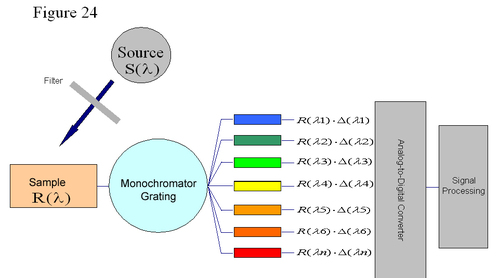
Spectro-photocolorimeters
They combine a monochromator with a normalized light source. For each wavelength, the light reflected by the sample is compared to the light reflected by a reference white surface under the same conditions of lighting and observation (see figure 24). One can then determine the (diffuse) reflectance spectrum
 of the sample.
of the sample.

Two types of spectrocolorimeters can be found, according to the type of photodetector used:
-
A single detector is capturing the light dispersed by the monochromator: in this case the the diffraction grating of the monochromator is rotated thanks to a precision stepper motor.
-
A photodiode array is set at the exit of the monochromator in order to acquire the spectrum in one single step (Optical Multichannel Analyzer).
Furthermore, different measurement heads can be coupled to the monochromator:
-
For diffusive materials (either in reflection or in transmission), the samples (the sample to be measured and the reference sample) is directly fixed onto the measurement head, which is connected to the monochromator either directly or through an optical fiber.
-
For self-emitting sources (LCD or CRT displays for instance), the measurement head is independent of the monochromator, and connected to the latter with an optical fiber.